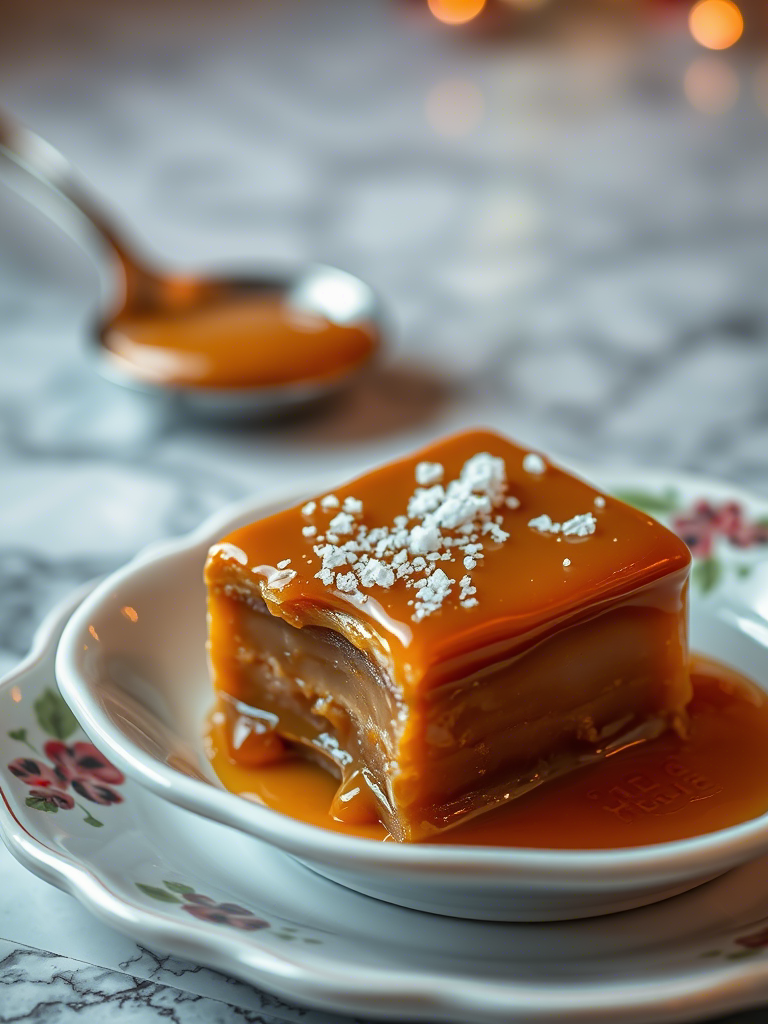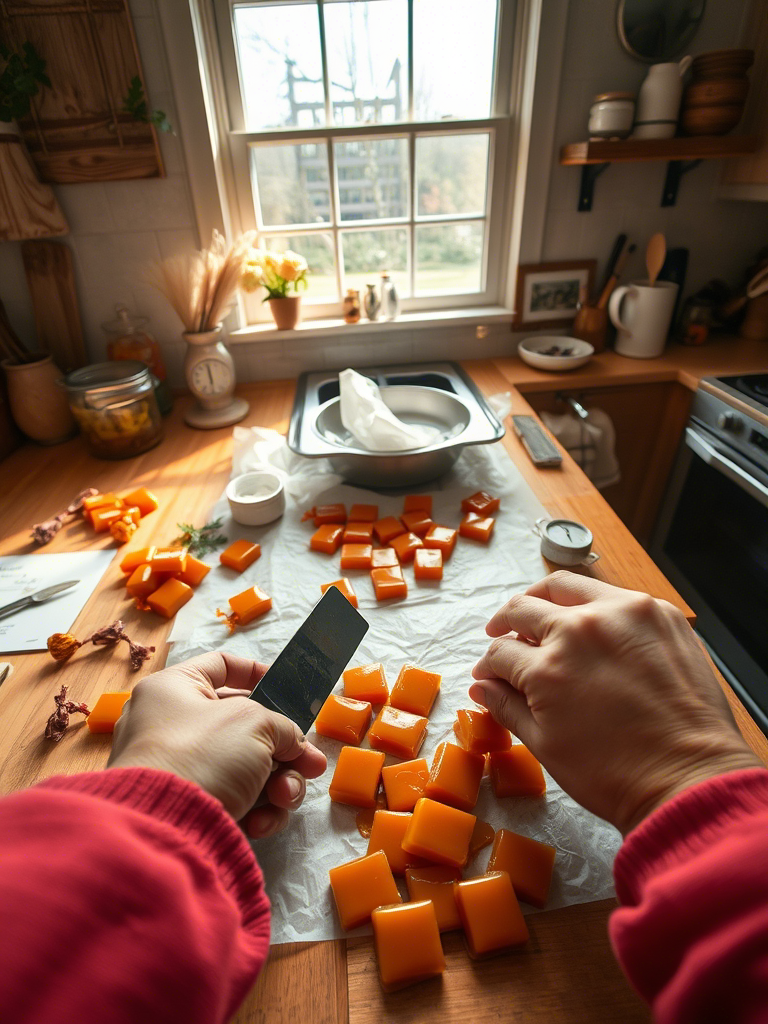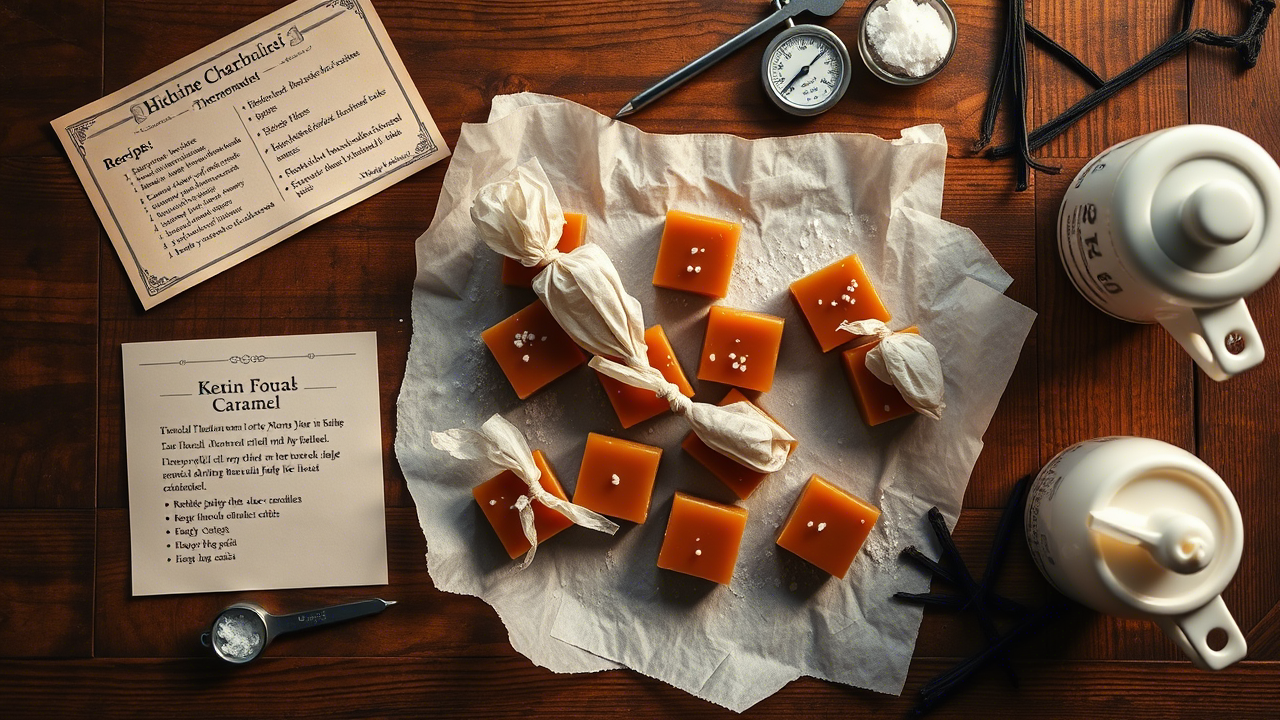It always starts the same. Somewhere near the middle of December, someone walks into your kitchen, pinches a square of gold-wrapped caramel, bites, pauses—and then leans in like they’re about to share state secrets. “You made this? Yourself?”
The answer, of course, is yes. And if you’re reading this, I’d wager you’re one of us—someone who believes caramel is more than sugar and cream. It’s history, technique, a kind of alchemy. Especially around Christmas, when making it becomes something bigger. A ritual. A memory being boiled to soft-ball stage.
This article digs deep into what makes a perfect homemade Christmas caramel. We’ll go far beyond the recipe card, into the science, the pitfalls, the cultural importance—and yes, the sweet spot of temperature that separates chewy perfection from jawbreaking regret.
The Roots: Why Christmas Caramels Are Still a Thing (and Always Will Be)
You ever notice how some candies vanish from culture, and others stick like molasses? Caramels are the latter. While their origins aren’t exactly stamped with a date and time, most food historians agree they crept into the American consciousness in the late 1800s, riding the coattails of industrial sugar production.
By the 1920s, they were a holiday staple. Kraft, of all things, helped commercialize the trend. But homemade caramels held on tight. Especially in the Midwest. In towns like Des Moines, Salt Lake, or Sioux Falls, you’ll still find grandmas wielding candy thermometers like sabers every December.
The draw? They’re luxurious, but humble. Sweet, but not cloying. And there’s that melt—slow, deep, silky.
The Science of Sugar: Where Chemistry Meets Nostalgia
Alright, let’s get nerdy for a sec. Caramels are what food scientists call a “non-crystalline candy.” This means you’re working not toward brittle sugar crystals (like fudge or toffee), but toward a dense, amorphous mass.
The holy trifecta of ingredients—sugar, butter, and heavy cream—isn’t just a taste decision. It’s chemical warfare. Sugar alone caramelizes at around 340°F (170°C), but in caramels, we usually aim for a finish temperature of 245°F to 250°F (118–121°C). That’s the soft-ball stage.
Why not hotter? Because heat’s a liar. Every degree above that threshold increases brittleness. By 260°F, you’re at firm-ball stage. Say goodbye to soft chew.
A touch of corn syrup (or glucose, if you’re fancy) is usually added not for taste, but to inhibit crystallization. This keeps the sugar from turning gritty. Professionals use glucose syrup, because it’s more predictable. But don’t tell Aunt Patty—she swears by Karo.
Fat Is Flavor: Don’t Skimp on the Cream
Here’s a stat that might surprise you: in professional caramel kitchens, butter and cream often make up over 35% of the total batch weight. That’s a lot. But fat is what carries flavor. And flavor, not just sweetness, is what makes homemade caramels sing.
Cream brings lactose and casein into the mix—two compounds that brown beautifully through Maillard reactions. That means more than just color. It’s where those nutty, toasty, deep caramel notes come from. No amount of fake flavoring can replicate that.
Some old-school recipes even call for a splash of evaporated milk. Adds a slight “cooked” dimension, a whisper of old-timey.

Salt: The Unsung Hero
If you’re not salting your caramels, what even are you doing?
Salt doesn’t just counteract sweetness. It sharpens the other flavors like a whetstone. Fleur de sel, Maldon, pink Himalayan—each brings its own signature.
Try this sometime: make two batches, one with standard table salt, one with flaked sea salt folded in at the end. Give them to people without telling ’em what’s different. The one with flake salt always wins. Always.
Equipment: The Difference Between Success and Disaster
Yes, grandma did it without a thermometer. But also, grandma probably overcooked a third of her batches and passed them off as “crunchy chews.”
Professionals use digital thermometers calibrated every couple of weeks. Accuracy is everything. A $15 thermometer that reads 3 degrees high? That’s the difference between buttery heaven and a dentist bill.
Use a heavy-bottomed pan. Caramels burn fast on thin aluminum. Stir constantly at first, gently toward the end. And don’t scrape the sides once it starts to darken—unless you enjoy crystallized grit in your final product.
Timing: Why the Last Five Minutes Matter More Than the First 45
Most of the cooking process is mellow. You melt sugar, add cream, bring it up slow. But the last five degrees go fast—sometimes in under a minute.
Step away and it’s over.
If you’re aiming for a firmer caramel for wrapping, 248°F is usually your goldilocks zone. For a softer chew (maybe to dunk in chocolate later), stop at 245°F.
Pull it too early, and it never sets. Overshoot? Break out the hammer.
Flavor Variations: Not All Caramels Have to Be Vanilla
Here’s where the artistry comes in. The base is sacred, yes. But that doesn’t mean you can’t riff.
Try these:
- Espresso Caramels: Add 2 teaspoons of instant espresso dissolved in a bit of cream. Chocolate-dipped, these are devastating.
- Smoked Salt + Bourbon: Infuse the cream with a splash of decent bourbon and finish with smoked Maldon flakes.
- Cardamom + Orange Zest: Bold, fragrant, and surprisingly grown-up.
Infusions should be gentle and added early—let flavors mellow during cooking. Extracts? Add off-heat. Alcohol burns off fast if added too early.

Packaging: Presentation Matters More Than You Think
There’s a reason we wrap them. Not just for looks.
Proper wrapping (wax paper > parchment > cellophane) prevents sticking and air exposure. Caramels attract moisture. Unwrapped, they go gooey or grainy in a few days.
Hand-wrapping 200 pieces is tedious—but that’s the magic. That’s the memory. Put on Nat King Cole, wear socks you don’t care about, and lean in.
For professionals: invest in a twist-wrapper machine if you’re doing this commercially. You’ll thank me around batch #40.
Shelf Life and Storage: Longevity Tips for the Pros
Wrapped caramels can last up to 3 weeks at room temp, longer if refrigerated. But cold can change texture slightly—makes ’em a little firm and less chewy.
Some pros vacuum-seal in small batches. Keeps ’em fresh for up to 2 months. Just don’t freeze them. Ever. Ice crystals do horrifying things to texture.
Common Mistakes (And How Not to Make Them Twice)
- Undercooked sugar: Result? Caramels that never firm up.
- Over-stirring late-stage: Encourages crystallization.
- Not pre-measuring ingredients: Timing’s too tight to scramble mid-batch.
- Wrong pot size: Overflow risk is real. Caramel boils high before settling.
- Using margarine: Just… don’t.
Emerging Trends: Gourmet Caramels on the Rise
Gourmet caramels are quietly exploding. A 2023 report by Specialty Food Association noted a 16% increase in small-batch caramel makers in the US since 2020.
Customers want nostalgic foods with a luxury edge. Caramels hit both notes.
Look to Japan and Scandinavia for inspiration. Yuzu caramels. Licorice caramels. Even matcha versions. The trick is balance—caramel’s delicate. Overdo it and the base flavor disappears.
Final Thoughts: The Legacy of a Chewy Tradition
Homemade Christmas caramels aren’t just candy. They’re edible time capsules.
They’re also a study in patience, precision, and restraint. A batch of caramels teaches more than most culinary school modules. It’s sugarcraft boot camp. Burn it once, and you’ll never look away from the thermometer again.
But when you get it right? When it’s soft but holds shape, buttery but not greasy, sweet with just enough salt bite—you’ll see it in people’s eyes. That wide-eyed wonder. That second piece they pretend not to want.
And maybe, just maybe, someone’ll ask for the recipe. Which you, of course, will hand over—minus one tiny detail.
FAQs
What temperature should I cook caramels to for perfect chewiness?
Cook to 245°F–250°F (soft-ball stage) for chewy, not brittle, caramels.
Why is corn syrup added to caramel recipes?
It prevents sugar crystallization, keeping caramels smooth and creamy.
Can I use margarine instead of butter in caramels?
No, margarine lacks the fat and flavor needed for quality caramel.
How do I prevent my caramels from sticking together?
Wrap each piece in wax or parchment paper to avoid moisture and sticking.
What’s the best salt to use in caramel?
Flaked sea salt like Maldon or fleur de sel enhances flavor best.
Can I add flavors like espresso or bourbon to caramels?
Yes, add infusions early during cooking or extracts off-heat for best results.
How long do homemade caramels last?
Wrapped, they last about 3 weeks at room temperature, longer if refrigerated.
Should I freeze caramels for longer storage?
No, freezing damages texture by forming ice crystals.
What common mistakes ruin homemade caramels?
Undercooking, over-stirring late, wrong pot size, and using margarine.
Why use a candy thermometer when making caramels?
Precise temperature control ensures the right texture and prevents burning.

Mariana is a passionate home cook who creates delicious, easy-to-follow recipes for busy people. From energizing breakfasts to satisfying dinners and indulgent desserts, her dishes are designed to fuel both your body and hustle.
When she’s not in the kitchen, she’s exploring new flavors and dreaming up her next recipe to share with the Foodie Hustle community.

